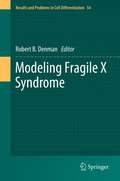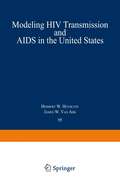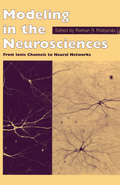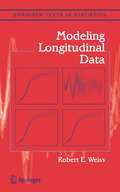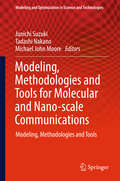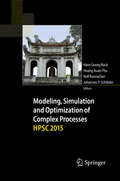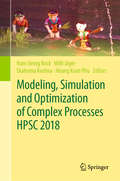- Table View
- List View
Modeling Demographic Processes in Marked Populations (Environmental and Ecological Statistics #3)
by Michael J. Conroy Evan G. Cooch David L ThomsonHere, biologists and statisticians come together in an interdisciplinary synthesis with the aim of developing new methods to overcome the most significant challenges and constraints faced by quantitative biologists seeking to model demographic rates.
Modeling Discrete Time-to-Event Data (Springer Series in Statistics)
by Gerhard Tutz Matthias SchmidThis book focuses on statistical methods for the analysis of discrete failure times. Failure time analysis is one of the most important fields in statistical research, with applications affecting a wide range of disciplines, in particular, demography, econometrics, epidemiology and clinical research. Although there are a large variety of statistical methods for failure time analysis, many techniques are designed for failure times that are measured on a continuous scale. In empirical studies, however, failure times are often discrete, either because they have been measured in intervals (e.g., quarterly or yearly) or because they have been rounded or grouped. The book covers well-established methods like life-table analysis and discrete hazard regression models, but also introduces state-of-the art techniques for model evaluation, nonparametric estimation and variable selection. Throughout, the methods are illustrated by real life applications, and relationships to survival analysis in continuous time are explained. Each section includes a set of exercises on the respective topics. Various functions and tools for the analysis of discrete survival data are collected in the R package discSurv that accompanies the book.
Modeling Dose-Response Microarray Data in Early Drug Development Experiments Using R: Order-Restricted Analysis of Microarray Data (Use R!)
by Dan Lin, Ziv Shkedy, Daniel Yekutieli, Dhammika Amaratunga and Luc BijnensThis book focuses on the analysis of dose-response microarray data in pharmaceutical settings, the goal being to cover this important topic for early drug development experiments and to provide user-friendly R packages that can be used to analyze this data. It is intended for biostatisticians and bioinformaticians in the pharmaceutical industry, biologists, and biostatistics/bioinformatics graduate students.Part I of the book is an introduction, in which we discuss the dose-response setting and the problem of estimating normal means under order restrictions. In particular, we discuss the pooled-adjacent-violator (PAV) algorithm and isotonic regression, as well as inference under order restrictions and non-linear parametric models, which are used in the second part of the book.Part II is the core of the book, in which we focus on the analysis of dose-response microarray data. Methodological topics discussed include:• Multiplicity adjustment• Test statistics and procedures for the analysis of dose-response microarray data• Resampling-based inference and use of the SAM method for small-variance genes in the data• Identification and classification of dose-response curve shapes• Clustering of order-restricted (but not necessarily monotone) dose-response profiles• Gene set analysis to facilitate the interpretation of microarray results• Hierarchical Bayesian models and Bayesian variable selection• Non-linear models for dose-response microarray data• Multiple contrast tests• Multiple confidence intervals for selected parameters adjusted for the false coverage-statement rateAll methodological issues in the book are illustrated using real-world examples of dose-response microarray datasets from early drug development experiments.
Modeling Fragile X Syndrome (Results and Problems in Cell Differentiation #54)
by Robert B. DenmanIntroduction.-Probing Astrocyte Function in Fragile X Syndrome.- Neural Stem Cells.- Fragile X Mental Retardation Protein (FMRP) and the Spinal Sensory System.– The Role of the Postsynaptic Density in the Pathology of the Fragile X Syndrome.- Behavior in a Drosophila model of Fragile X.- Molecular and Genetic Analysis of the Drosophila Model of Fragile X Syndrome.- Fragile X Mental Retardation Protein and Stem Cells.- Manipulating the Fragile X Mental Retardation Proteins in the Frog.- Exploring the Zebra finch Taeniopygia gutta as a Novel Animal Model for the Speech-language Deficit of Fragile X Syndrome.- Neuroendocrine Alterations in the Fragile X Mouse.- Taking STEPs forward to understanding Fragile X Syndrome.- Fmr-1 as an Offspring Genetic and a Maternal Environmental Factor in Neurodevelopmental Disease.- Mouse Models of the Fragile X Premutation and the Fragile X Associated Tremor/Ataxia Syndrome.- Clinical Aspects of the Fragile X Syndrome.- Fragile X Syndrome: A Psychiatric Perspective.- Fragile X Syndrome and Targeted Treatment Trials.- The Fragile X-associate Tremor Ataxia Syndrome.- Vignettes: Models in Absentia.
Modeling HIV Transmission and AIDS in the United States (Lecture Notes in Biomathematics #95)
by Herbert W. Hethcote James W. Van ArkThe disease that came to be called acquired immunodeficiency syndrome (AIDS) was first identified in the summer of 1981. By that time, nearly 100,000 persons in the United States may have been infected with human immunodeficiency virus (HIV). By the time the routes of transmission were clearly identified and HIV was established as the cause of AIDS in 1983, over 300,000 people may have been infected. That number has continued to increase, with approximately 1,000,000 Americans believed to be infected in 1991. The epidemic is of great public health concern because HlV is infectious, causes severe morbidity and death in most if not all of those infected, and often occurs in relatively young persons. In addition, the cost of medical care for a person with HIV disease is high, and the medical care needs of HIV-infected persons place a severe burden on the medical care systems in many areas. Understanding and controlling the HIV epidemic is a particularly difficult challenge. The long and variable period between HIV infection and clinical disease makes it difficult both to forecast the future magnitude of the epidemic, which is important for health care planning, and to estimate the number infected in the last several years, which is important for monitoring the current status of the epidemic.
Modeling & Imaging of Bioelectrical Activity: Principles and Applications (Bioelectric Engineering)
by Bin HeOver the past several decades, much progress has been made in understanding the mechanisms of electrical activity in biological tissues and systems, and for developing non-invasive functional imaging technologies to aid clinical diagnosis of dysfunction in the human body. The book will provide full basic coverage of the fundamentals of modeling of electrical activity in various human organs, such as heart and brain. It will include details of bioelectromagnetic measurements and source imaging technologies, as well as biomedical applications. The book will review the latest trends in the field and comment on the future direction in this fast developing line of research.
Modeling in Biopharmaceutics, Pharmacokinetics and Pharmacodynamics: Homogeneous and Heterogeneous Approaches (Interdisciplinary Applied Mathematics #30)
by Panos Macheras Athanassios IliadisThe state of the art in Biopharmaceutics, Pharmacokinetics, and Pharmacodynamics Modeling is presented in this new second edition book. It shows how advanced physical and mathematical methods can expand classical models in order to cover heterogeneous drug-biological processes and therapeutic effects in the body.The book is divided into four parts; the first deals with the fundamental principles of fractals, diffusion and nonlinear dynamics; the second with drug dissolution, release, and absorption; the third with epirical, compartmental, and stochastic pharmacokinetic models, with two new chapters, one on fractional pharmacokinetics and one on bioequivalence; and the fourth mainly with classical and nonclassical aspects of pharmacodynamics. The classical models that have relevance and application to these sciences are also considered throughout. This second edition has new information on reaction limited models of dissolution, non binary biopharmaceutic classification system, time varying models, and interface models. Many examples are used to illustrate the intrinsic complexity of drug administration related phenomena in the human, justifying the use of advanced modeling methods.This book will appeal to graduate students and researchers in pharmacology, pharmaceutical sciences, bioengineering, and physiology.Reviews of the first edition:"This book presents a novel modelling approach to biopharmaceutics, pharmacokinetics and pharmacodynamic phenomena. This state-of-the-art volume will be helpful to students and researchers in pharmacology, bioengineering, and physiology. This book is a must for pharmaceutical researchers to keep up with recent developments in this field." (P. R. Parthasarathy, Zentralblatt MATH, Vol. 1103 (5), 2007)"These authors are the unique (or sole) contributors in this area that are working on these questions and bring a special expertise to the field that is now being recognized as essential to understanding biological system and kinetic/dynamic characteristics in drug development...This text is an essential primer for those who would envision the incorporation of heterogeneous approaches to systems where homogeneous approaches are not sufficient to describe the system." (Robert R. Bies, Journal of Clinical Pharmacology, Vol. 46, 2006)
Modeling in Biopharmaceutics, Pharmacokinetics and Pharmacodynamics: Homogeneous and Heterogeneous Approaches (Interdisciplinary Applied Mathematics #30)
by Panos Macheras Athanassios IliadisThis book presents a novel modeling approach to biopharamceutics, pharmacokinetics and pharmacodynamic phenomena. It shows how advanced physical and mathematical methods can expand classical models in order to cover heterogeneous drug-biological processes and therapeutic effects in the body. Throughout, many examples are used to illustrate the intrinsic complexity of drug administration related phenomena in the human, justifying the use of advanced modeling methods.
Modeling in the Neurosciences: From Ionic Channels to Neural Networks
by R. R. PoznanskiWith contributions from more than 40 renowned experts, Modeling in the Neurosciences: From Ionic Channels to Neural Networks is essential for those interested in neuronal modeling and quantitative neiroscience. Focusing on new mathematical and computer models, techniques and methods, this monograph represents a cohesive and comprehensive treatment
Modeling in the Neurosciences: From Ionic Channels to Neural Networks
by Roman R. PoznanskiWith contributions from more than 40 renowned experts, Modeling in the Neurosciences: From Ionic Channels to Neural Networks is essential for those interested in neuronal modeling and quantitative neiroscience. Focusing on new mathematical and computer models, techniques and methods, this monograph represents a cohesive and comprehensive treatment
Modeling Infectious Disease Parameters Based on Serological and Social Contact Data: A Modern Statistical Perspective (Statistics for Biology and Health #63)
by Niel Hens Ziv Shkedy Marc Aerts Christel Faes Pierre Van Damme Philippe BeutelsMathematical epidemiology of infectious diseases usually involves describing the flow of individuals between mutually exclusive infection states. One of the key parameters describing the transition from the susceptible to the infected class is the hazard of infection, often referred to as the force of infection. The force of infection reflects the degree of contact with potential for transmission between infected and susceptible individuals. The mathematical relation between the force of infection and effective contact patterns is generally assumed to be subjected to the mass action principle, which yields the necessary information to estimate the basic reproduction number, another key parameter in infectious disease epidemiology. It is within this context that the Center for Statistics (CenStat, I-Biostat, Hasselt University) and the Centre for the Evaluation of Vaccination and the Centre for Health Economic Research and Modelling Infectious Diseases (CEV, CHERMID, Vaccine and Infectious Disease Institute, University of Antwerp) have collaborated over the past 15 years. This book demonstrates the past and current research activities of these institutes and can be considered to be a milestone in this collaboration. This book is focused on the application of modern statistical methods and models to estimate infectious disease parameters. We want to provide the readers with software guidance, such as R packages, and with data, as far as they can be made publicly available.
Modeling Infectious Diseases in Humans and Animals
by Matt J. Keeling Pejman RohaniFor epidemiologists, evolutionary biologists, and health-care professionals, real-time and predictive modeling of infectious disease is of growing importance. This book provides a timely and comprehensive introduction to the modeling of infectious diseases in humans and animals, focusing on recent developments as well as more traditional approaches. Matt Keeling and Pejman Rohani move from modeling with simple differential equations to more recent, complex models, where spatial structure, seasonal "forcing," or stochasticity influence the dynamics, and where computer simulation needs to be used to generate theory. In each of the eight chapters, they deal with a specific modeling approach or set of techniques designed to capture a particular biological factor. They illustrate the methodology used with examples from recent research literature on human and infectious disease modeling, showing how such techniques can be used in practice. Diseases considered include BSE, foot-and-mouth, HIV, measles, rubella, smallpox, and West Nile virus, among others. Particular attention is given throughout the book to the development of practical models, useful both as predictive tools and as a means to understand fundamental epidemiological processes. To emphasize this approach, the last chapter is dedicated to modeling and understanding the control of diseases through vaccination, quarantine, or culling. Comprehensive, practical introduction to infectious disease modeling Builds from simple to complex predictive models Models and methodology fully supported by examples drawn from research literature Practical models aid students' understanding of fundamental epidemiological processes For many of the models presented, the authors provide accompanying programs written in Java, C, Fortran, and MATLAB In-depth treatment of role of modeling in understanding disease control
Modeling Infectious Diseases in Humans and Animals
by Matt J. Keeling Pejman RohaniFor epidemiologists, evolutionary biologists, and health-care professionals, real-time and predictive modeling of infectious disease is of growing importance. This book provides a timely and comprehensive introduction to the modeling of infectious diseases in humans and animals, focusing on recent developments as well as more traditional approaches. Matt Keeling and Pejman Rohani move from modeling with simple differential equations to more recent, complex models, where spatial structure, seasonal "forcing," or stochasticity influence the dynamics, and where computer simulation needs to be used to generate theory. In each of the eight chapters, they deal with a specific modeling approach or set of techniques designed to capture a particular biological factor. They illustrate the methodology used with examples from recent research literature on human and infectious disease modeling, showing how such techniques can be used in practice. Diseases considered include BSE, foot-and-mouth, HIV, measles, rubella, smallpox, and West Nile virus, among others. Particular attention is given throughout the book to the development of practical models, useful both as predictive tools and as a means to understand fundamental epidemiological processes. To emphasize this approach, the last chapter is dedicated to modeling and understanding the control of diseases through vaccination, quarantine, or culling. Comprehensive, practical introduction to infectious disease modeling Builds from simple to complex predictive models Models and methodology fully supported by examples drawn from research literature Practical models aid students' understanding of fundamental epidemiological processes For many of the models presented, the authors provide accompanying programs written in Java, C, Fortran, and MATLAB In-depth treatment of role of modeling in understanding disease control
Modeling Inhibitors of Matrix Metalloproteinases (QSAR in Environmental and Health Sciences)
by Tarun JhaMatrix metalloproteinases (MMPs) have been established as promising biomolecular targets for novel drug design and discovery against numerous major disease conditions including various cancers, cardiovascular, neurodegenerative, inflammatory diseases, and more. This book covers various modern molecular modeling methodologies particularly related to MMP inhibitors. Included in the text are descriptions of ligand-based drug designing and structure-based drug designing modeling strategies for designing potential and target specific or selective MMPIs. This book will benefit those who are looking for an in-depth text on the design and discovery processes of novel and selective MMPIs. Features Describes modeling strategies applied to MMPs Elaborates on the designing strategies of MMPs specifically Includes in-depth analyses of related case studies Acts as a guide for medicinal chemists, not only from pharmaceutical industries, but also from academia Covers various modern molecular modeling methodologies, particularly related to MMPIs
Modeling Inhibitors of Matrix Metalloproteinases (QSAR in Environmental and Health Sciences)
Matrix metalloproteinases (MMPs) have been established as promising biomolecular targets for novel drug design and discovery against numerous major disease conditions including various cancers, cardiovascular, neurodegenerative, inflammatory diseases, and more. This book covers various modern molecular modeling methodologies particularly related to MMP inhibitors. Included in the text are descriptions of ligand-based drug designing and structure-based drug designing modeling strategies for designing potential and target specific or selective MMPIs. This book will benefit those who are looking for an in-depth text on the design and discovery processes of novel and selective MMPIs. Features Describes modeling strategies applied to MMPs Elaborates on the designing strategies of MMPs specifically Includes in-depth analyses of related case studies Acts as a guide for medicinal chemists, not only from pharmaceutical industries, but also from academia Covers various modern molecular modeling methodologies, particularly related to MMPIs
Modeling Longitudinal Data (Springer Texts in Statistics)
by Robert E. WeissThe book features many figures and tables illustrating longitudinal data and numerous homework problems. The associated web site contains many longitudinal data sets, examples of computer code, and labs to re-enforce the material. Weiss emphasizes continuous data rather than discrete data, graphical and covariance methods, and generalizations of regression rather than generalizations of analysis of variance.
Modeling, Methodologies and Tools for Molecular and Nano-scale Communications: Modeling, Methodologies And Tools (Modeling and Optimization in Science and Technologies #9)
by Junichi Suzuki Tadashi Nakano Michael John MooreThis book reports on cutting-edge modeling techniques, methodologies and tools used to understand, design and engineer nanoscale communication systems, such as molecular communication systems. Moreover, it includes introductory materials for those who are new to the field. The book’s interdisciplinary approach, which merges perspectives in computer science, the biological sciences and nanotechnology, will appeal to graduate students and researchers in these three areas.The book is organized into five parts, the first of which describes the fundamentals of molecular communication, including basic concepts, models and designs. In turn, the second part examines specific types of molecular communication found in biological systems, such as neuronal communication in the brain. The book continues by exploring further types of nanoscale communication, such as fluorescence resonance energy transfer and electromagnetic-based nanoscale communication, in the third part, and by describing nanomaterials and structures for practical applications in the fourth. Lastly, the book presents nanomedical applications such as targeted drug delivery and biomolecular sensing.
Modeling of Biological Materials (Modeling and Simulation in Science, Engineering and Technology)
by Francesco Mollica Luigi Preziosi K. R. RajagopalThis unique collection highlights the central role played by modeling in general, and the modeling of mechanical considerations that have an effect on living matter. The volume collects several survey papers by actively working specialists, dealing with some of the most important problems – both theoretical and practical – in biomechanics. Written in a user-friendly style, these papers clearly explain both the biomedical and mechanical backgrounds associated with complex phenomena. This book may be used in interdisciplinary introductory courses covering various biomechanical topics for graduate students in applied mathematics, engineering, and biomedicine.
Modeling of Physiological Flows (MS&A #5)
by Davide Ambrosi, Alfio Quarteroni and Gianluigi RozzaThis book offers a mathematical update of the state of the art of the research in the field of mathematical and numerical models of the circulatory system. It is structured into different chapters, written by outstanding experts in the field. Many fundamental issues are considered, such as: the mathematical representation of vascular geometries extracted from medical images, modelling blood rheology and the complex multilayer structure of the vascular tissue, and its possible pathologies, the mechanical and chemical interaction between blood and vascular walls, and the different scales coupling local and systemic dynamics. All of these topics introduce challenging mathematical and numerical problems, demanding for advanced analysis and efficient simulation techniques, and pay constant attention to applications of relevant clinical interest. This book is addressed to graduate students and researchers in the field of bioengineering, applied mathematics and medicine, wishing to engage themselves in the fascinating task of modeling the cardiovascular system or, more broadly, physiological flows.
Modeling Phase Transitions in the Brain (Springer Series in Computational Neuroscience #4)
by D. Alistair Steyn-Ross Moira Steyn-RossForeword by Walter J. Freeman. The induction of unconsciousness using anesthetic agents demonstrates that the cerebral cortex can operate in two very different behavioral modes: alert and responsive vs. unaware and quiescent. But the states of wakefulness and sleep are not single-neuron properties---they emerge as bulk properties of cooperating populations of neurons, with the switchover between states being similar to the physical change of phase observed when water freezes or ice melts. Some brain-state transitions, such as sleep cycling, anesthetic induction, epileptic seizure, are obvious and detected readily with a few EEG electrodes; others, such as the emergence of gamma rhythms during cognition, or the ultra-slow BOLD rhythms of relaxed free-association, are much more subtle. The unifying theme of this book is the notion that all of these bulk changes in brain behavior can be treated as phase transitions between distinct brain states. Modeling Phase Transitions in the Brain contains chapter contributions from leading researchers who apply state-space methods, network models, and biophysically-motivated continuum approaches to investigate a range of neuroscientifically relevant problems that include analysis of nonstationary EEG time-series; network topologies that limit epileptic spreading; saddle--node bifurcations for anesthesia, sleep-cycling, and the wake--sleep switch; prediction of dynamical and noise-induced spatiotemporal instabilities underlying BOLD, alpha-, and gamma-band Hopf oscillations, gap-junction-moderated Turing structures, and Hopf-Turing interactions leading to cortical waves.
Modeling Reality with Mathematics
by Alfio QuarteroniSimulating the behavior of a human heart, predicting tomorrow's weather, optimizing the aerodynamics of a sailboat, finding the ideal cooking time for a hamburger: to solve these problems, cardiologists, meteorologists, sportsmen, and engineers can count on math help. This book will lead you to the discovery of a magical world, made up of equations, in which a huge variety of important problems for our life can find useful answers.
Modeling, Simulation and Optimization in the Health- and Energy-Sector (SEMA SIMAI Springer Series #14)
by René Pinnau Nicolas R. Gauger Axel KlarThis volume is addressed to people who are interested in modern mathematical solutions for real life applications. In particular, mathematical modeling, simulation and optimization is nowadays successfully used in various fields of application, like the energy- or health-sector. Here, mathematics is often the driving force for new innovations and most relevant for the success of many interdisciplinary projects. The presented chapters demonstrate the power of this emerging research field and show how society can benefit from applied mathematics.
Modeling, Simulation and Optimization of Complex Processes HPSC 2015: Proceedings of the Sixth International Conference on High Performance Scientific Computing, March 16-20, 2015, Hanoi, Vietnam
by Hans Georg Bock Hoang Xuan Phu Rolf Rannacher Johannes P. SchlöderThis proceedings volume highlights a selection of papers presented at the Sixth International Conference on High Performance Scientific Computing, which took place in Hanoi, Vietnam on March 16-20, 2015. The conference was jointly organized by the Heidelberg Institute of Theoretical Studies (HITS), the Institute of Mathematics of the Vietnam Academy of Science and Technology (VAST), the Interdisciplinary Center for Scientific Computing (IWR) at Heidelberg University, and the Vietnam Institute for Advanced Study in Mathematics, Ministry of Education The contributions cover a broad, interdisciplinary spectrum of scientific computing and showcase recent advances in theory, methods, and practical applications. Subjects covered numerical simulation, methods for optimization and control, parallel computing, and software development, as well as the applications of scientific computing in physics, mechanics, biomechanics and robotics, material science, hydrology, biotechnology, medicine, transport, scheduling, and industry.
Modeling, Simulation and Optimization of Complex Processes HPSC 2018: Proceedings of the 7th International Conference on High Performance Scientific Computing, Hanoi, Vietnam, March 19-23, 2018
by Hans Georg Bock Willi Jäger Ekaterina Kostina Hoang Xuan PhuThis proceedings volume highlights a selection of papers presented at the 7th International Conference on High Performance Scientific Computing, which took place in Hanoi, Vietnam, during March 19-23, 2018. The conference has been organized by the Institute of Mathematics of the Vietnam Academy of Science and Technology, the Interdisciplinary Center for Scientific Computing (IWR) of Heidelberg University and the Vietnam Institute for Advanced Study in Mathematics. The contributions cover a broad, interdisciplinary spectrum of scientific computing and showcase recent advances in theory, methods, and practical applications. Subjects covered include numerical simulation, methods for optimization and control, machine learning, parallel computing and software development, as well as the applications of scientific computing in mechanical engineering, airspace engineering, environmental physics, decision making, hydrogeology, material science and electric circuits.
Modeling Survival Data: Extending the Cox Model (Statistics for Biology and Health)
by Terry M. Therneau Patricia M. GrambschThis book is for statistical practitioners, particularly those who design and analyze studies for survival and event history data. Building on recent developments motivated by counting process and martingale theory, it shows the reader how to extend the Cox model to analyze multiple/correlated event data using marginal and random effects. The focus is on actual data examples, the analysis and interpretation of results, and computation. The book shows how these new methods can be implemented in SAS and S-Plus, including computer code, worked examples, and data sets.



